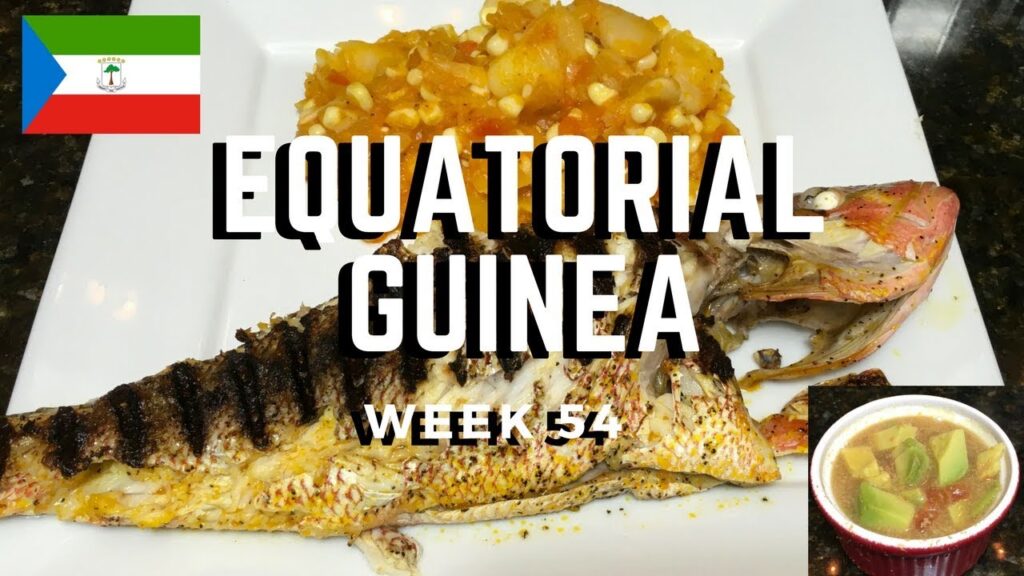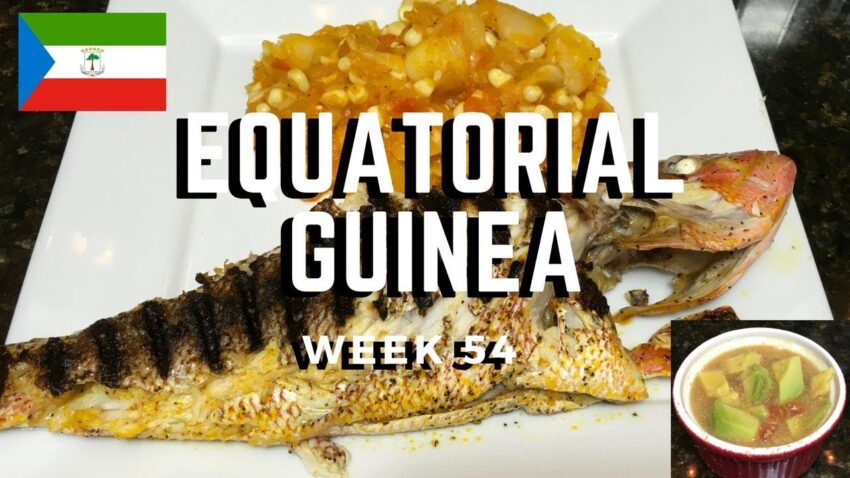
A Culinary Journey Through Equatorial Guinea: Exploring Traditional Food
Equatorial Guinea, a small nation on the west coast of Central Africa, boasts a rich and diverse culinary heritage. The equatorial guinea traditional food scene reflects the country’s geographical location, cultural influences, and historical background. From hearty stews to flavorful seafood dishes, the cuisine offers a unique taste of Africa. This article delves into the fascinating world of equatorial guinea traditional food, exploring its key ingredients, popular dishes, and the cultural significance behind them. We’ll uncover the flavors that define this vibrant nation and provide insights into the cooking techniques that have been passed down through generations.
Key Ingredients in Equatorial Guinean Cuisine
Equatorial guinea traditional food relies heavily on locally sourced ingredients. The abundance of the Atlantic Ocean provides a variety of fresh seafood, while the fertile land yields a range of fruits, vegetables, and root crops. Some of the most common ingredients include:
- Plantains: A staple food, plantains are used in various forms – boiled, fried, mashed, or grilled. They serve as a versatile side dish or a key ingredient in main courses.
- Cassava: Another important root crop, cassava is often ground into flour and used to make fufu, a dough-like accompaniment to stews and soups.
- Fish and Seafood: Given its coastal location, fish and seafood are integral to equatorial guinea traditional food. Common catches include barracuda, snapper, prawns, and crabs.
- Groundnuts (Peanuts): Groundnuts are used extensively in sauces and stews, adding richness and flavor.
- Palm Oil: A widely used cooking oil, palm oil contributes a distinct flavor and color to many dishes.
- Spices: A variety of spices, including ginger, garlic, chili peppers, and local herbs, are used to season dishes and create complex flavor profiles.
Popular Equatorial Guinean Dishes
Several dishes stand out as quintessential examples of equatorial guinea traditional food. These dishes offer a glimpse into the country’s culinary identity and are often served during special occasions and family gatherings.
Pepper Soup
Pepper soup is a spicy and flavorful broth made with meat (usually goat, chicken, or fish), chili peppers, and a blend of local spices. It’s often served as a starter or a light meal and is known for its warming and invigorating properties. Different regions may have variations in the ingredients and spice levels, reflecting local preferences. It’s a cornerstone of equatorial guinea traditional food.
Okra Soup
Okra soup is a popular dish throughout West and Central Africa, and Equatorial Guinea is no exception. It’s made with okra, meat or fish, tomatoes, onions, and spices. The okra gives the soup a slightly slimy texture, which is considered a delicacy by many. It’s typically served with fufu or rice. The preparation of Okra soup showcases the skillful blending of flavors that defines equatorial guinea traditional food.
Sua (Grilled Fish)
Sua, or grilled fish, is a simple yet flavorful dish. The fish is marinated in a mixture of spices, including ginger, garlic, and chili peppers, and then grilled over an open flame. The result is a smoky and succulent dish that is often served with plantains or cassava. The freshness of the fish is key to the success of this equatorial guinea traditional food staple.
Fufu
Fufu is a staple food in many African countries, including Equatorial Guinea. It’s a dough-like dish made from boiled and pounded starchy vegetables, such as cassava, plantains, or yams. Fufu is typically served as an accompaniment to soups and stews, and it’s eaten by tearing off small pieces and using them to scoop up the sauce. The texture and flavor of fufu can vary depending on the ingredients used. Understanding fufu is crucial to understanding equatorial guinea traditional food.
Nsuk a Mbong (Palm Nut Soup)
Nsuk a Mbong, or palm nut soup, is a rich and flavorful soup made with palm nuts, meat (usually chicken or goat), and spices. The palm nuts are boiled and pounded to extract their oil and flavor, which is then used to create a creamy and aromatic broth. It’s a labor-intensive dish but is considered a delicacy in equatorial guinea traditional food. It’s often served during special occasions.
Bushmeat
In some rural areas, bushmeat, or meat from wild animals, is consumed as part of the diet. This can include animals such as antelope, monkeys, and rodents. However, it’s important to note that the consumption of bushmeat can pose health risks and contribute to the decline of wildlife populations. While part of the historical equatorial guinea traditional food landscape, its consumption is increasingly discouraged due to sustainability and health concerns.
The Cultural Significance of Food in Equatorial Guinea
Food plays a significant role in Equatorial Guinean culture. Meals are often shared communally, and food is seen as a way to connect with family and friends. Traditional cooking methods and recipes have been passed down through generations, preserving cultural heritage. Certain dishes are associated with specific celebrations and rituals, reflecting the importance of food in social and cultural life. Exploring equatorial guinea traditional food is therefore also exploring the culture.
For example, palm nut soup is often served during weddings and other important ceremonies. Pepper soup is believed to have medicinal properties and is often given to people who are feeling unwell. The act of sharing a meal is seen as a sign of hospitality and generosity. The preparation and consumption of equatorial guinea traditional food are deeply embedded in the social fabric of the nation.
Modern Influences on Equatorial Guinean Cuisine
While equatorial guinea traditional food remains a vital part of the country’s culinary landscape, modern influences are also shaping the way people eat. The introduction of new ingredients and cooking techniques from other parts of the world has led to a fusion of flavors and styles. Urban areas often have restaurants serving international cuisine, reflecting the growing diversity of the population. However, there is also a renewed interest in preserving and promoting traditional dishes, ensuring that they continue to be enjoyed by future generations.
The influence of Spanish cuisine, due to the country’s colonial past, is also evident in some dishes. For instance, rice is a common accompaniment to many meals, and dishes like paella have been adapted to incorporate local ingredients. This blending of culinary traditions adds another layer of complexity to equatorial guinea traditional food.
Where to Experience Equatorial Guinean Cuisine
Experiencing equatorial guinea traditional food can be a rewarding culinary adventure. While restaurants specializing solely in Equatorial Guinean cuisine may be limited, particularly outside of the country, there are still opportunities to sample authentic dishes. Local markets are a great place to find fresh ingredients and learn about traditional cooking methods. Some restaurants in major cities like Malabo and Bata offer a selection of traditional dishes on their menus. Additionally, seeking out local families or community events can provide a more immersive and authentic culinary experience.
For travelers, trying the local cuisine is an essential part of understanding the culture. Don’t be afraid to ask questions about the dishes and ingredients. Engage with the locals and learn about their culinary traditions. This will not only enhance your travel experience but also contribute to the preservation of equatorial guinea traditional food.
Preserving Culinary Heritage
The preservation of equatorial guinea traditional food is crucial for maintaining cultural identity and promoting culinary tourism. Efforts are being made to document traditional recipes, promote local ingredients, and support small-scale farmers and producers. Culinary schools and training programs are also playing a role in educating future generations about the importance of preserving culinary heritage. By supporting these initiatives, we can help ensure that the flavors of Equatorial Guinea continue to be enjoyed for years to come. [See also: African Cuisine: A Global Perspective]
In conclusion, equatorial guinea traditional food offers a fascinating glimpse into the country’s rich cultural heritage. From the use of locally sourced ingredients to the unique cooking methods and the cultural significance of food, the cuisine is a reflection of the nation’s history and identity. By exploring and appreciating these culinary traditions, we can gain a deeper understanding of Equatorial Guinea and its people.
